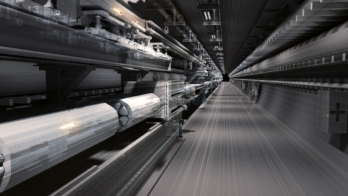
“It is our vision for CERN to be a role model for environmentally responsible research,” writes CERN Director-General Fabiola Gianotti in her introduction to a landmark environmental report released by the laboratory on 9 September. While CERN has a longstanding framework in place for environmental protection, and has documented its environmental impact for decades, this is its first public report. Two years in the making, and prepared according to the Global Reporting Initiative Sustainability Reporting Standards, it details the status of CERN’s environmental footprint, along with objectives for the coming years.
Given the energy consumption of large particle accelerators, environmental impact is a topic of increasing importance for high-energy physics research worldwide. Among the recommendations of the 2020 update of the European strategy for particle physics was a strong emphasis on the need to continue with efforts to minimise the environmental impact of accelerator facilities and maximise the energy efficiency of future projects.
When the Large Hadron Collider (LHC) is operating, CERN uses an average of 4300 TJ of electricity every year (30–50% less when not in operation) – enough energy to power just under half of the 200,000 homes in the canton of Geneva. “This is an inescapable fact, and one that CERN has always taken into consideration when designing new facilities,” states Frédérick Bordry, director for accelerators and technology.
Action plan
An energy-management panel established at CERN in 2015 has already led to actions, including free cooling and air-flow optimisation, better optimised LHC cryogenics, and the implementation of SPS magnetic cycles and stand-by modes, which significantly reduce energy consumption. The LHC delivered twice as much data per Joule in its second run (2015–2018) compared to its first (2010–2013), states the new report. With the High-Luminosity LHC due to deliver a tenfold increase in luminosity towards the end of the decade, CERN has made it a priority to limit the increase in energy consumption to 5% up to the end of 2024, with longer-term objectives to be set in future reports.
CERN procures its electricity mainly from France, whose production capacity is 87.9% carbon-free. In terms of direct greenhouse-gas emissions, the 192,000 tonnes of carbon-dioxide equivalent emitted by CERN in 2018 is mainly due to fluorinated gases used in the LHC detectors for cooling, particle detection, air conditioning and electrical insulation. CERN has set a formal objective that, by 2024, direct greenhouse emissions will be reduced by 28% by replacing fluorinated gases – which were designed in the 1990s to be ozone-friendly – with carbon dioxide, which has a global-warming potential several thousand times lower.
CERN has set a formal objective that, by 2024, direct greenhouse emissions will be reduced
by 28%
Other areas of environmental significance studied in the report include radiation exposure, noise and waste. CERN commits to limit the emission of ionising radiation to no more than 0.3 mSv per year – less than a third of the annual dose limit for public exposure set by the European Council. The report states that the actual dose to any member of the public living in the immediate vicinity of CERN due to the laboratory’s activities is below 0.02 mSv per year, which is less than the exposure received from cosmic radiation during a transatlantic flight.
A 2018 measurement campaign showed that noise levels at CERN have not changed since the early 1990s, and are low by urban standards. Nevertheless, CERN has have invested 0.7 million CHF to reduce noise at its perimeters to below 70 dB during the day and 60 dB at night (which corresponds to the level of conversational speech). The organisation has also introduced approaches to preserve the local landscape and protect flora, including 15 species of orchid growing on CERN’s sites.
Waste not
Water consumption, mostly drawn from Lac Léman, has slowly decreased over the past 10 years, the report notes, and CERN commits to keeping the increase in water consumption below 5% to the end of 2024, despite a growing demand for cooling from upgraded facilities. CERN also eliminates 100% of its waste, states the report, and has a recycling rate of 56% for non-hazardous waste (which comprises 81% of the total). A major project under construction since last year will see waste hot water from the cooling system for LHC Point 8 (where the LHCb experiment is located) channeled to a heating network in the nearby town of Ferney-Voltaire from 2022, with LHC Points 2 and 5 being considered for similar projects.
CERN plans to release further environment reports every two years. “Today, more than ever, science’s flag-bearers need to demonstrate their relevance, their engagement, and their integration into society as a whole,” writes Gianotti. “This report underlines our strong commitment to environmental protection, both in terms of minimising our impact and applying CERN technologies for environmental protection.”





